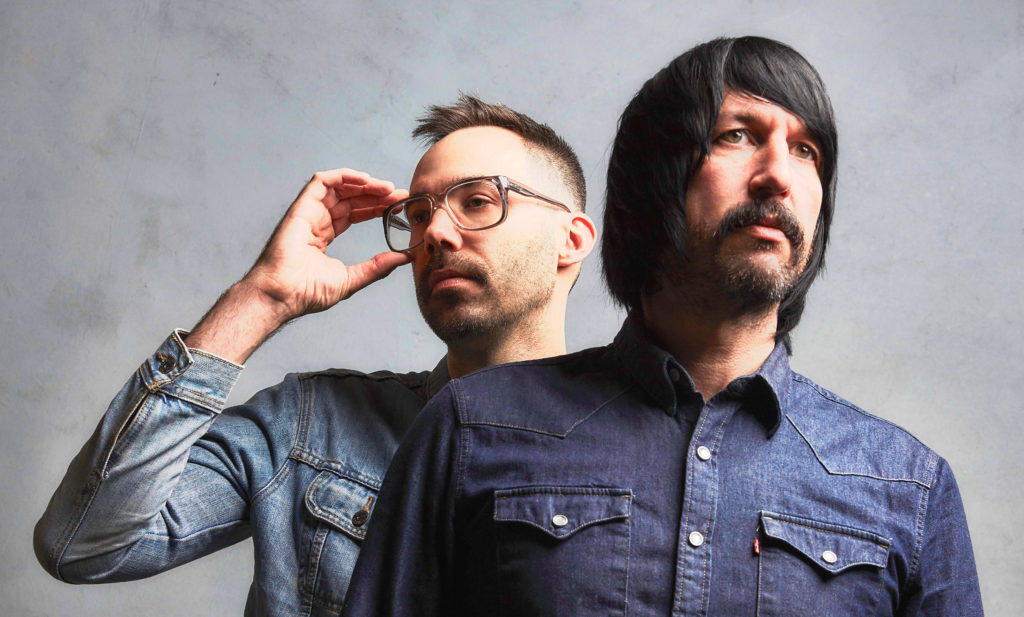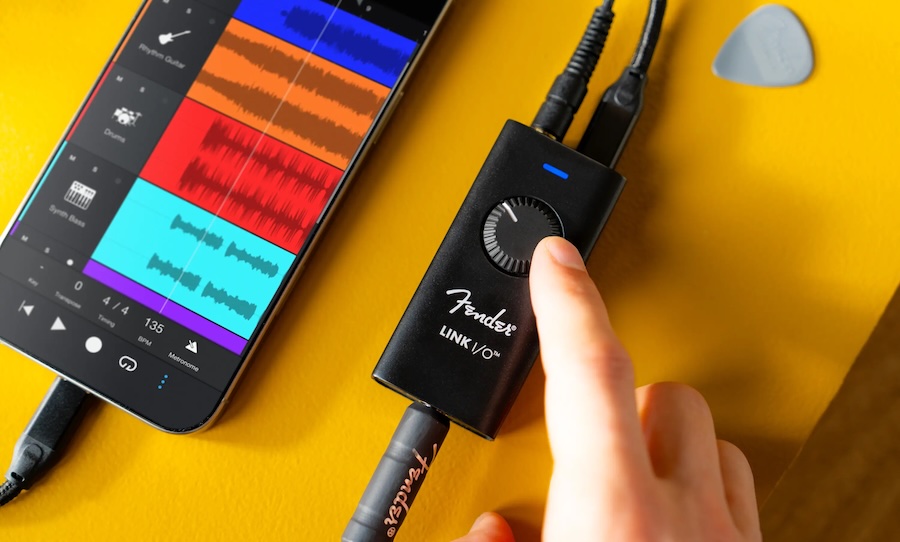As the world welcomes Death From Above 1979’s new album, Is 4 Lovers, we get into the nitty-gritty with songwriter and producer, Sebastien Grainger.
Emerging at the turn of the millennium, Toronto outfit Death From Above 1979 was a wunderkind of the naughties indie explosion. It wasn’t long, however, before they got off the relentless touring treadmill. Throughout the lengthy hiatus, the restlessly creative duo — populated by Sebastien Grainger (drums and vocals) and Jesse F. Keeler (bass and synth) — continued to explore musical possibilities in various projects. Eventually — and inevitably — the partnership was eventually brought back to life.
20 years on from their formation, the band continues to expand the sonic possibilities of a two-piece. Is 4 Lovers is made from the ever-present, core materials, but marries the band’s tonal brutality with fresh and progressive melodic and harmonic directions. What’s more, they took control of the creative process — from the first recording, right up until the final masters. We caught up with songwriter, engineer and producer Sebastien Grainger to learn how the album came together.

HAPPY: In keeping with the finest traditions of Death From Above 1979, Is 4 Lovers is dripping with distortion. Do you have any go-to options for different sounds? For example, “this my favourite distortion plugin for vocals, or this is my favourite pedal for bass”.
SEBASTIEN: I wouldn’t say there’s a standard across the board for the band, but certainly we were influenced by dirtier music. I remember when we made our very first recording, the producer/engineer Al-P ran two channels of a preamp on full into two channels of a compressor on full. Full on, ya know.
This time around, I did almost all the vocals through this little piece of outboard gear called a Level-Or, which is a 500-series module that replicates this old Realistic from Radio Shack. I don’t know if you are aware of Radio Shack in Australia, but they had this compressor that sounded like shit, and now, everyone wants that sound (laughs). There’s actually a plugin from Soundtoys that does it. But I did almost everything analog. It had a lot of colour.
The strategy was to commit to sounds very early and to make them colourful early. So I had a mix of digital with a whole big rack of outboard gear. There’s nothing clean. Everything added colour, that was kind of the M.O. Committing early and going “that’s the sound”. I wouldn’t recommend this for any other professionals, but I went into the Standard Audio Level-Or for almost every vocal on the record.
HAPPY: Wow, that is commitment. Even though the tones are so upfront, you manage to carve out some breathing space. Can you talk us through that approach? Was it a conscious effort to give people respite?
SEBASTIEN: In the band dynamic, when it comes to sheer volume, I’m probably the more reasonable one (laughs). I’ve been sitting in the crossfire of his [bassist Jesse F. Keeler’s] amplifiers for 20 years, so more than anyone on earth, I know what that’s all about.
I’m sensitive to the audience in a sense. When we go and play a show, I would love to be like Bruce Springsteen and play a three-hour show, but I know that no one on earth can tolerate three hours of Death From Above, let alone really want it. I think 90 minutes is pushing it. So when it comes time to make an album, you want that dynamic movement. You want there to be a story.
If I go see a Marvel movie or an action movie or something, as soon as two things have exploded, I’m basically asleep. I get exhausted by that high level of action, so I don’t wanna have that effect on people. I would say that Mean Streets is the metaphor for the grand dynamic. It’s a bait and switch. It’s a soft song, then you’ve got a Crass or Bad Brains song in the middle.
This record was created very holistically in that we recorded the music together in five weeks. Then I took that music and turned into songs over the course of eight or nine months and did it with my head down. I wasn’t thinking about too many outside things. I was just following instinct. Even the track order — it wasn’t a labour. Sometimes it’s hard to figure out the order things will go into and this time, I don’t even remember having a discussion about it. I just remember sending all the songs and Jesse said “perfect” (laughs).
HAPPY: That’s quite interesting because I feel like the record is broken up into two halves. For me, the first half ends with NYC Power Elite II. That track feels like it’s so crunched that it’s going to collapse under the weight of all that distortion, then Totally Wiped Out comes in and there’s suddenly more space. Things get even more adventurous with Glass Homes and Love Letter. Conceptually, it feels well-considered…
SEBASTIEN: Well, we probably recorded 40 ‘things’, that could’ve been contenders. And because I’m the songwriter per se, I have to turn it into something. I take off the musician hat and put on the songwriter hat and in this case, I was also the engineer and mixer. So it was kind of everything. So I would try to work on a bunch of different songs and go with whatever would stick. I didn’t wanna work on something too hard. If it wasn’t easy for me to come up with a good idea for the song melodically or lyrically, then maybe there was something about it that wasn’t working. If it was hard for me, maybe it would be hard for the audience.
This is something that we learned from Eric Valentine, who we worked with on the last record. He told Jesse at one point that, “if it’s hard to play, it might be hard to listen to”. So I took that to heart on this as well. I followed my heart on the songs and how I was selecting them. And then when the vibe of the record started to be weighted toward one side or the other, I was like, “ok, now we need to add some movement.” At that point, I’d ask Jesse for more stuff, because I know what the record’s going to be, essentially, there are just some missing pieces.
In this case, the missing pieces were Love Letter and actually almost the entire second half of the record. There was something I wanted to happen there. He had a demo for No War. I didn’t wanna touch it because sometimes Jesse will go into these modes of…his riff will have every single note in it (laughs). As a person who’s about to write a melody, I’m like, “how do write a melody?” It’s like a 12-tone row, like experimental music.
So with No War, it was this 32-bar melody that he was playing on the bass. I was very reluctant to do anything with it. Once I unlocked that song, I was like, “that’s the closer”. Then I got him to fish around on his voice notes and he said “I’ve got this piano part that I’ve been playing forever”. The band is us, right, it’s not a third thing. It’s not something that has a specific sound or direction, it’s just what happens when we make music together.
So for him to give me the Love Letter piano part — that’s a gift. I would never have written that song on my own. I write all kinds of songs on my own, but I never would have written that song on my own. And I don’t think if anyone were to guess that they would think that Death From Above wrote that song. But we can. That was a late contender, but it made the record more important for me and it tied together the Is 4 Lovers theme, which was already guiding the project.
HAPPY: And taking on all the production duties yourself, did that offer any more freedom than you had on previous records?
SEBASTIEN: There was no point where we had to justify anything to anyone. We’ve been threatening to make our own records for a while, but something always got in the way. I don’t think the time was ever right for it. But there’s a point when I realised that, you know, I’ve made a bunch of records on my own. When we were making The Physical World with Dave Sardy, I was also making a solo record that I did everything on. So it’s not like I can’t do that.
And Jesse, he also makes complete albums with MSTRKRFT where no one touches them but him and Al-P. So from my perspective, I treated it almost like a solo record and I treated Jesse like a precious material. Like he was oil, or iron, and I was mining him. So for those five weeks, I was getting the precious material from him and then I took that and made a record with it.
With the nature of my role as the songwriter, it’s gonna take me longer and I’m gonna need more time with the music. And if I’m also capable of sculpting it and editing it and engineering it, I think we’ve unlocked something very valuable for our band here. I love going deep into the details. It’s a fun process to be writing lyrics, but also listening to the same snare hit for four hours, trying to EQ something out. It’s a really weird, hybrid experience.
Is 4 Lovers is out now. Head over to the Death From Above 1979 website for all the details.



